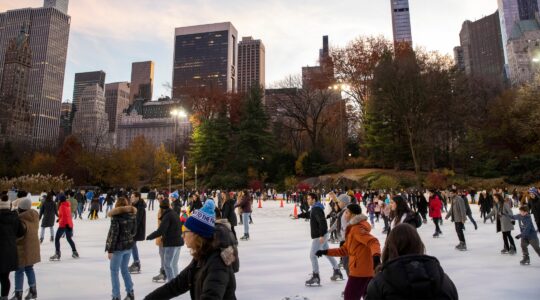When Joseph Benatov started showing Jewish travelers around his homeland in the 1990s, post-Communist Bulgaria was decidedly off the tourism radar. Visitors were generally Israelis with family ties to Bulgaria’s Sephardic community, or those seeking a cheap vacation (and a local guide to decipher the Slavic tongue).
Two decades later, “it has changed so much, and for the better,” said Benatov, who two years ago launched his own Jewish heritage tour outfit, Sephardic Balkans. Benatov was referring to Sofia, the Bulgarian capital, but the statement could apply just as easily to the entire region: Today’s travelers enjoy hassle-free E.U. border crossings, restored Jewish synagogues and cemeteries, and English translations everywhere from menus to museums.
I met Benatov by chance at a park in Philadelphia, where he teaches Hebrew in the Jewish studies department at the University of Pennsylvania. Since my husband is from the Balkans (he and Benatov actually went to college together, though they didn’t know each other), we visit the region frequently, and I was eager to ply a savvy colleague for insights.
Few are savvier than Benatov, a connoisseur of everything from modern Israeli literature (which he translates) to red wine (he enjoys introducing American oenophiles to the Balkans’ storied wine regions). Benatov learned Hebrew after his Sephardic family emigrated to Tel Aviv in the 1990s; in the decades since, his travels and scholarship have plumbed the intersections of East European, Jewish and American cultures.
“If you think of Jewish travel to Eastern Europe, you think Ashkenazic heritage,” said Benatov, whose clientele is primary American Jews. “But people are interested in the communities they don’t know about.”
Bulgaria, which is proud of having saved its Jews during World War II, fits the bill, along with underexplored Macedonia and Northern Greece. Between these three destinations, visitors can tour the 19th-century villas of Thessaloniki’s Jewish elite, sample marzipan with the Ladino-speaking sisterhood at the Sofia JCC, and visit a newly restored Jewish cemetery in Bitola, for centuries the heart of Macedonia’s Jewish community. “We’ve been going there from the start, but this year it looked very different,” said Benatov.
In his view, travelers should take advantage of a post-communist renaissance to explore the historical ties between Ottoman-era Sephardic communities across the southern Balkans, which were a nexus of Jewish life after the Iberian expulsion.
“Thessaloniki was a majority-Jewish city, the Jerusalem of the Balkans,” noted Benatov, who has observed a recent revival of Jewish life in Greece’s second city; on his last recent trip there, he visited a newly opened kosher restaurant that specializes in traditional Greek-Sephardic dishes, and toured a mosque with Jewish imagery built by Jews who converted publicly to Islam in the 17th century. And new memorials and museums dedicated to the Holocaust era have opened in Kyustendil, Bulgaria and Skopje, Macedonia, Benatov noted.
He added that Americans are particularly impressed by Plovdiv, a Bulgarian city on the ancient spice route that is sprucing up for its 2019 turn as a European Capital of Culture. “They’ve revived the old neighborhoods, and now there are funky galleries, art spaces, a lot of nightlife,” said Benatov (who also told me, to my great relief, that the city has smoothed out its notoriously ankle-busting cobblestones).
Benatov is constantly tweaking his tours, allowing for more time in the places tourists enjoy most (Thessaloniki) and emphasizing the diversity of Sephardic and Balkan cuisine. “People love the food,” he said. A vegetarian, he praised the region’s bountiful salads, non-meat specialties and fresh fish (foil-wrapped to kosher standards).
When I told him I’d tasted the most emblematic Balkan dishes at family dinners instead of in restaurants, Benatov said he’d found a solution: home-based meals, a popular new addition to many small-group tours. After reading rave reviews about one chef in the Sofia press, for instance, Benatov located her in the tiny Bulgarian village of Arbanassi; the chef now hosts a home-cooked meal for Benatov’s travelers, then teaches them to make yogurt and phyllo pastry called banitsa. (I’d never heard of Arbanassi, but Benatov recommended its 19th-century ambiance and National Revival architecture; I put it on my list.)
And while trolling a foodie website, Benatov encountered a Macedonian pastry buff who now leads the groups through Skopje’s ancient bazaar, where they eat their way through variations on baklava. “It’s a true Oriental town,” Benatov noted of the city, where cafés are filled with men drinking Turkish coffee and fiddling with beads over backgammon.
That Old World scene takes place against a backdrop of nouvelle kitsch, as Skopje rebuilds its Socialist-era center with gilded monuments. Similar scenarios are unfolding across the Balkans, with the medieval Bulgarian hill town of Veliko Turnovo, for instance, unveiling a remodeled, tourist-ready downtown.
Even as tangible infrastructure improves, Benatov reminded me that an intangible heritage is slipping away, lending his own travels a certain poignancy. “We meet with Holocaust survivors, with a community that speaks to each other in Ladino,” he said. “But I don’t know for how much longer.” For now, at least, Sephardic Balkan travel is in a sweet spot.
The New York Jewish Week brings you the stories behind the headlines, keeping you connected to Jewish life in New York. Help sustain the reporting you trust by donating today.




